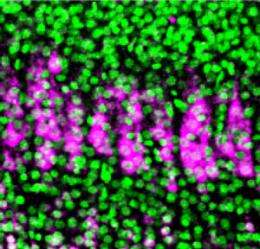Confirmation of repeated patterns of neurons indicates stereotypical organization throughout brain's cerebral cortex

Neurons are arranged in periodic patterns that repeat over large distances in two areas of the cerebral cortex, suggesting that the entire cerebral cortex has a stereotyped organization, reports a team of researchers led by Toshihiko Hosoya of the RIKEN Brain Science Institute. The entire cortex has a stereotypical layered structure with the same cell types arranged in the same way, but how neurons are organized in the other orientation—parallel to the brain’s surface—is poorly understood.
Hosoya and his colleagues therefore examined layer V (5) of the mouse cortex, which contains two classes of large pyramidal neurons that look identical but differ in the connections they form. One projects axons straight down to regions beneath the cortex; the other projects to the cortex on the opposite side of the brain.
First, the researchers examined expression of the id2 gene in cells of the visual cortex, because these cells form clusters in that part of the brain. They found that id2 is expressed in nearly all cells that project axons downward, but not in those that cross over. Hosoya and colleagues verified this by visualizing the connections of cells using fluorescent cholera toxin, which binds to cell membranes and travels along the axons.
Further examination of gene expression patterns in tissue slices revealed that the cells are arranged in clusters aligned perpendicular to the brain’s surface, and that the clusters are organized in a regular pattern, with the same basic unit repeating every thirty micrometers (Fig. 1). They also observed the same pattern in layer V of the somatosensory cortex, suggesting that this organization is common to all other areas.
By generating a strain of mutant mice expressing green fluorescent protein in the progenitor cells that produce the cells in layer V during brain development, Hosoya and his colleagues investigated the embryonic origin of these cells. This revealed that each cluster contains neurons that are produced by different progenitor cells.
Finally, the researchers showed that the regular pattern persists in the adult visual cortex, and that neurons in each cluster show the same activity patterns in response to visual stimulation. “Our preliminary data suggest that at least several other areas in the cortex have the same structure,” says Hosoya. “It’s likely that the entire cortex has the same organization, and I expect that the human cortex has the same structure.”
More information: Maruoka, H., Kubota, K., Kurokawa, R., Tsuruno, S. & Hosoya, T. Periodic organization of a major subtype of pyramidal neurons in neocortical layer V. The Journal of Neuroscience 31, 18522–18542 (2011). www.jneurosci.org/content/31/50/18522.abstract



















